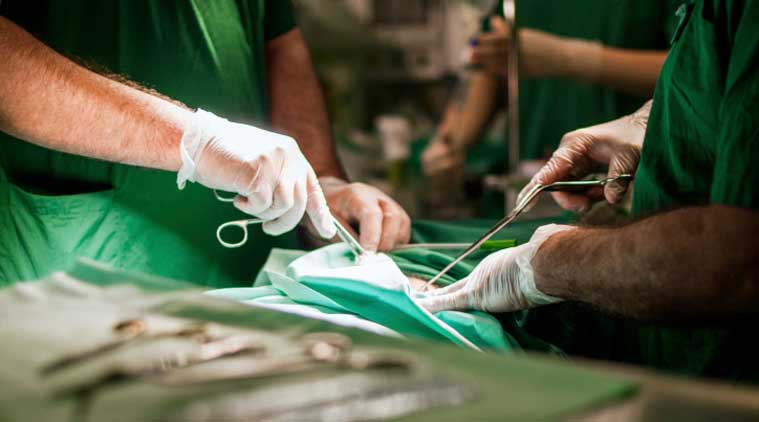 Most elective surgeries that use the minimal invasive method have been indefinitely postponed. (Source: Thinkstock Images)
Most elective surgeries that use the minimal invasive method have been indefinitely postponed. (Source: Thinkstock Images)
Laparoscopy and endoscopy, surgery’s biggest boons to patients owing to smaller incisions, lesser blood loss and reduced post-operative hospitalisation while minimising pain, have run into a giant speed-breaker and are staring at their biggest challenge to date: Covid-19.
Most elective surgeries that use the minimal invasive method have been indefinitely postponed. And procedures deemed urgent are tightrope walks for OT pros weighing the risks of balancing surgical precision with protecting staff from virus contamination. Robotic surgeries that put assisting staff or surgical scrub nurses at risk have also been stopped for the moment.
At the crux of the dilemma are insufflation and desufflation, keyhole surgery’s crucial steps of inflating the abdominal cavity with carbon dioxide (CO2) that creates space for surgeons to manoeuvre with their miniature equipment. This has led to fears of the virus escaping through the gas that gets released post-surgery in potential and Covid-positive patients, and contaminating the operating room.
Speaking on behalf of the Society of American Gastrointestinal and Endoscopic Surgeons (SAGES), Dr Dean Mikami MD, division chief, general surgery at John A Burn School at Hawaii, says American medical bodies have recommended that elective laparoscopic and endoscopic cases be postponed.
“For procedures deemed urgent or necessary, we strongly recommended that consideration be given to the possibility of viral contamination during laparoscopy, endoscopy and with the use of energy devices,” he said in an email interview.
According to Dr Shailesh Puntambekar, who heads the Galaxy Cancer Care centre in Pune, laparoscopy and endoscopy surgeons across India were following two sets of guidelines set out by SAGES and the European Association for Endoscopic Surgery (EAES) for emergency procedures.
“Precautions to be taken have become very important — lowering pressure during intubation, filtration to evacuate smoke and avoiding energy sources that will generate more smoke. Of course, there’s no compromising on N95 masks and PPE for everyone in the OT,” he said.
Puntambekar says laparoscopy surgeons will have to adapt quickly to the new set of precautions.
The CO2 conundrum is owing to surgeons’ fear that COVID-19 can lead to the surgical smoke becoming the carrier for potential viral particles — it has already been established that other viruses can get released during laparoscopy with carbon dioxide.
“Erring on the side of safety would warrant treating the SARS-CoV-2 virus as exhibiting a similar property. Although it has not been established that live SARS-CoV 2 viral particles can escape with surgical smoke and CO2 during laparoscopic surgery, other viruses have established this (Human Papilloma Virus, HPV, HIV),” said Mikami. He insists though that “a patient who is COVID-19 negative cannot catch the SARS-CoV 2 virus from the operating room”.
Exposure to particles and droplets during intubation and extubation poses a major risk as does infection via surface contamination and aerosolization of surgical smoke with potential viral particles. This has made filtration of surgical smoke and escaping CO2 all-important in COVID-19 patients undergoing laparoscopic surgery.
“Masks such as N95 respirators are designed to filter out 95% of particles that are 0.3 microns and larger. High-Efficiency Particulate Air (HEPA) filters have a minimum 99.97% efficiency rating for removing particles greater than or equal to 0.3 microns in diameter. Ultra-Low Particulate Air (ULPA) filters can remove from a minimum of 99.999% of airborne particles with a minimum particle penetration size of 0.05 microns,” said Mikami.
“Currently, the best practice for mitigating possible infectious transmission is multi-faceted: room filtration and ventilation, appropriate PPE, and smoke evacuation devices with a suction and filtration system,” he said.
Some of the other SAGES guidelines for laparoscopy include negative pressure rooms for intubations, presence of just the essential staff in OT and no mid-surgery swaps, individually fitted N95 masks and shaving of beards or other facial hair for surgeons.
Smaller incisions for ports to avoid leakage of the gas and operating on lower gas pressure in the abdomen — down to 10-11 mm from 14 mm, says Puntambekar — as well as cutting down on electrosurgery units are some of the other new stipulations.
Since the outbreak, only a couple of research papers from China and Italy have come out on how the pandemic impacts surgery, but there are accounts emerging from the UK of surgeons having to operate on positive patients who face fatalities not on account of the severity of the virus but because they need urgent surgical interventions.
Professor Nader Francis, Director at Northwick Park Institute for Medical Research in Harrow, London, says the UK has seen a 50% reduction in patients who need surgery and are reaching out to hospitals.
“Cases that have been pushed aside include cancer suspects who couldn’t be screened or diagnosed in time, or routine endoscopies or even those who could quickly escalate to advanced stages. We are trying to resume surgery, but how and where is uncertain as we are looking for consensus on how to reopen. Cold sites, remote from COVID treatments in private hospitals, are being considered,” said Francis, who is an endoscopy specialist and part of the EAES.
Mikami reckons the surgical community has learnt a big lesson. “This will change the rules of surgery moving forward… There will be a new standard of ‘universal precaution’ post the pandemic,” he said.